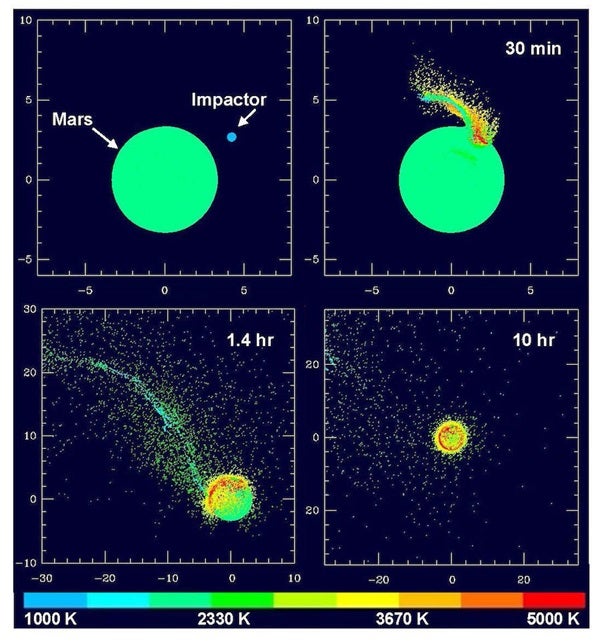SwRItv
According to a new study published today in Science Advances, Mars’ two moons — Phobos and Deimos — likely formed following an impact between proto-Mars and a minor planet roughly the size of Ceres, which is 587 miles wide (950 kilometers).
To carry out the study, the researchers created a new model that took into account interactions between martian moons, then simulated how a disk of material would form and evolve around Mars following a collision between the Red Planet and a large object. The novel approach allowed the team to track ejecta from the impact with resolutions a full order of magnitude better than previous studies.
“We used state-of-the-art models to show that a Vesta-to-Ceres-sized impactor can produce a disk consistent with the formation of Mars‘ small moons,” said co-author Julien Salmon, a research scientist at the Southwest Research Institute (SwRI), in a press release.
“The outer portions of the disk accumulate into Phobos and Deimos,” said Salmon, “while the inner portions of the disk accumulate into larger moons that eventually spiral inward and are assimilated into Mars. Larger impacts advocated in prior works produce massive disks and more massive inner moons that prevent the survival of tiny moons like Phobos and Deimos.”
Though prior researchers have attempted to model such a collision, the simulations typically fall short due to low resolution and oversimplified models. “Ours is the first self-consistent model to identify the type of impact needed to lead to the formation of Mars’ two small moons,” said lead author Robin Canup, an associate vice president in the SwRI Space Science and Engineering Division.
“A key result of the new work is the size of the impactor; we find that a large impactor — similar in size to the largest asteroids Vesta [326 miles wide] and Ceres [587 miles wide] — is needed, rather than a giant impactor,” said Canup. “The model also predicts that the two moons are derived primarily from material originating in Mars, so their bulk compositions should be similar to that of Mars for most elements. However, heating of the ejecta and the low escape velocity from Mars suggests that water vapor would have been lost, implying that the moons will be dry if they formed by impact.”
“A primary objective of the MMX mission is to determine the origin of Mars’ moons,” said Canup. “And having a model that predicts what the moons’ compositions would be if they formed by impact provides a key constraint for achieving that goal.”
To learn much more about Mars, check out our FREE Guide to Settling Mars, jointly produced by Astronomy and Discover magazines.











